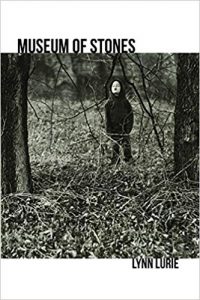Reviewed By Charli Smith

A life full of what ifs lends itself toward anxiety. The life of a new mother lends itself to the anxiety of the “what ifs.” In her novel Museum of Stones Lynn Lurie depicts the hardships and the bouts of anxiety driven mania of motherhood. “I asked the nurse to count his toes and then count them again. She holds a crumpled form in front of me… I count five toes, then, five more.” Through a mix of quick flash backs and unsettling time jumps, Lurie shows the fragility of the mind coupled with obsessive desire to protect and love a child.
Museum of Stones follows intertwined memories of an unnamed mother and the memories of her son. In a stream of consciousness like style, Lurie shows her readers the unraveling of a mother’s mind. “My son stops sleeping. Each night he stands in his crib and cries… I imagine leaving him alone in the house, imprisoned by the four sides of his crib… his diaper overflowing, the wet running down his leg. I do not intend to return.” As her son grows older, his patterns change, and her mind slowly dwindles. She is convinced her son has an illness that no doctor can diagnose. She is sure her son is going to die.
The story is made through Lurie’s subtle use of foreshadowing and the chaotic rhythm of memories. One moment the reader is learning about a character’s travel through the Middle East, and what it was like to provide medical care to the surrounding villages. The next moment the reader is thrust backward into the main character’s childhood, her breathing “deeply, hoping to hold onto the odor of mentholated cigarettes, hair spray, and sweet perfume” only to be transported to the present where she places “red pill-like capsules into the water and the sponges inside expand, taking the form of animals” to coax her son into the bathtub.
Throughout the novel, Lurie focusses on themes such as anxiety, memory, and the idea of collecting. Collecting things—pages, books, stones, bugs—collecting memories of the mother’s life as well as her son’s life, collecting fear. To express each theme, she bases them out of two main motifs: the idea of a house and sickness. Through the main character’s memories, the reader sees the multitude of homes she lives in. Each home creating a sense of apprehension from living in a hut, having to huddle close to keep from freezing in a snow storm, to living in a commune where she slept in her clothes and kept shoes by the front door in case of late night bathroom emergencies, to the home she shared with her son where racoons left behind feces and she was convinced he was being poisoned. Sickness, too, follows the main character through the length of the story. She aids in healing the sick, but when it comes to her son, no one can find a definitive answer to why he does not sleep, why his brain works the way it does, and why his affection is linked to the unique way his brain works.
Museum of Stones is a story about a unique little boy and his mother. How their lives impact each other in complicated ways. His perceived illness is the driving force behind his mother’s actions, and while she can see the irrationality behind her motivation, she cannot keep the fear at bay. Each new memory shown is a new clue into the mother’s psyche. Each new memory displays what it means to raise a child without losing oneself to the chaotic, anxiety driven mania that is “what if.”
